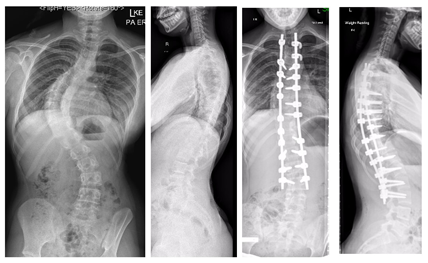Posterior Correction

Posterior Correction is the approach used for many of the cases of idiopathic scoliosis (double major scoliosis, double thoracic scoliosis and neuro-muscular scoliosis). This involves a long incision along the back. Specially designed screws, hooks or bands are placed in the spinal column carefully working around and on either side of the spinal cord. Rods (or Rail rods) are contoured to the desired shape of the spine. The implants are made of Titanium or Cobalt Chromium with some other trace metals.
The correction is then undertaken with Spinal Cord monitoring. There is a small risk of paralysis and needs to be discussed. Spinal cord monitoring ensures neurological safety of the correction.
The operated segments are fused and should not move in the future. Bone grafts are used to achieve fusion. These are partly the patients bone and partly donated bone. The screws and rods are not routinely removed. Sometimes an area does not fuse leading to a pseudarthrosis. This may need more surgery. This may be associated with infection or a rod breakage.
The other complications of this surgical approach are infection, deep vein thrombosis, pulmonary embolism.
Spinal Fusion Surgery:
A spine is made up of a series of interconnected bones stacked one on top of the other with discs placed between them. The facet joints and the intervertebral discs keep the bones together and are responsible for providing the bending and the twisting function to our everyday activities.
Everything works as a single unit to provide a stable healthy spine, and we run into problems if any elements of the spine are in trouble, for example, backaches. Though acute problems can be treated using physiotherapy and medication, the severe medical condition which can be a threat to the normal functioning and have to be sorted using surgery procedure like Spinal Fusion.
Spinal Fusion:
Spinal fusion is a surgical procedure where two or more spinal vertebrae are fused together with the help of bone graft material to eliminate the unnatural movement of the bones and restore the spine stability. This procedure is recommended by the scoliosis surgeon after identifying the cause of the pain using the careful study of medical history, physical exams, and imaging tests. Some of the conditions that can be treated using the procedure are:
- Vertebral Fracture
- Spinal Stenosis
- Spondylolysis
- Scoliosis
- Tumor or Infection of the spine
- Herniated disk
Spinal fusion solves the medical conditions where the pain is due to abnormal movement or, displacement of the spinal elements. This procedure of fusing the vertebrae eliminates the unnatural stretching of bones, nerves, muscles or ligaments which may be caused by the injuries normal wear and tear, arthritis or above mentioned medical conditions.
Procedure:
The procedure of Spinal fusion is successfully being performed from several years now and techniques are employed by the surgeons to accomplish the procedure. There are two approaches that can be taken to reach the spine:
Anterior Spinal Fusion: The surgeon approaches the spine from the front of the belly: lower abdomen for lumbar spine and neck for the cervical spine.
Posterior Spinal Correction using Spinal Fusion:
The spine is approached through an incision from the posterior side of the body for the posterior spinal correction surgery. After the incision is made, the spine’s curvature is corrected by carefully working around the spinal cord with specially designed screws, hooks, rods and bone grafts. Metal rods and screws are used to correct the spine and contour it to the desired shape. Entire correction is under taken using Spinal Cord monitoring to ensure neurological safety.
Over time as the healing takes place, the new spine fuses into the single bone to form a stable and healthy spine. Infection, deep vein thrombosis and pulmonary embolism are some of the complications of this procedure which are highly unlikely to occur when performed by a specialist Scoliosis Surgeon in UK. Bracing is not required after the surgery and the patient can return to the full scale routine within 6 months unless otherwise advised by the scoliosis surgeon. This Posterior Spinal Correction Surgery usually requires a 4-5 nights stay in hospital facility, followed by recovery using physiotherapy and pain relief medication.
Scoliosis Surgery Recovery and Rehabilitation:
Pain is the natural part of any surgical procedure including spinal fusion. Medication is prescribed by your doctor to minimize the pain and fasten the recovery process. The fused spine must be kept in proper alignment during the healing time. As it does take time for the bones to fuse together, the patients are coached the right movements to improve their activity levels
Light walking is usually recommended and as the patient slowly gains the strength, physical therapy can be employed to accelerate the recovery. Following a healthy lifestyle after the spinal correction surgery, with adequate rest and recommended exercise will improve the chances of successful recovery.


